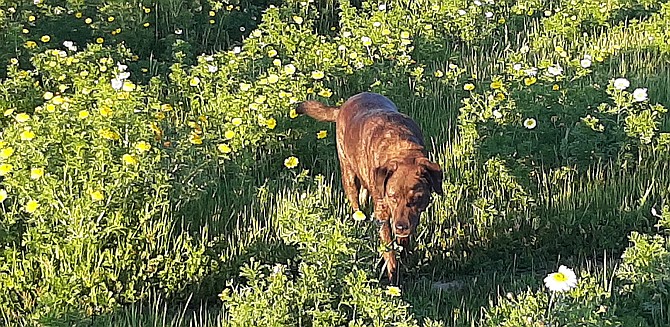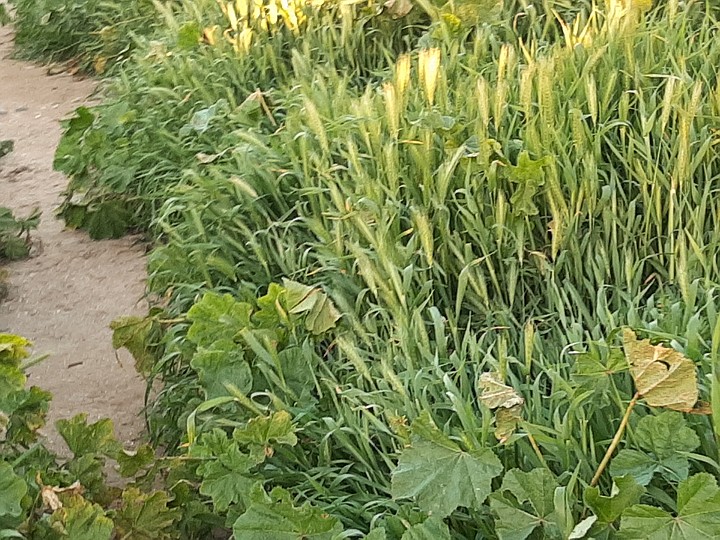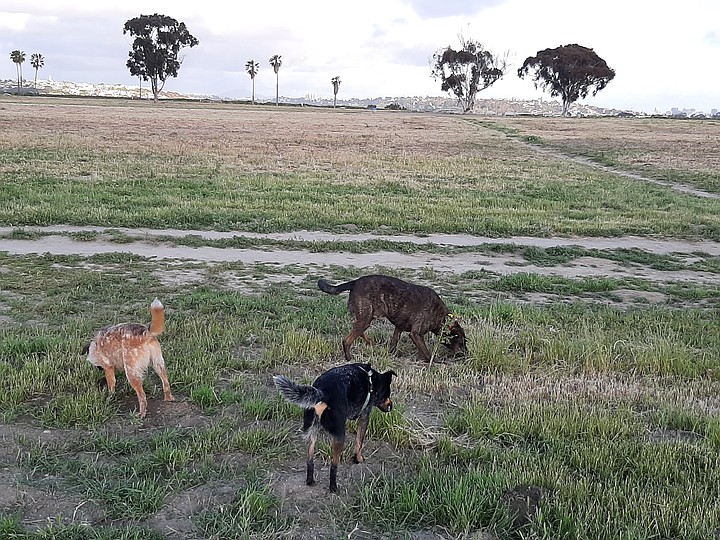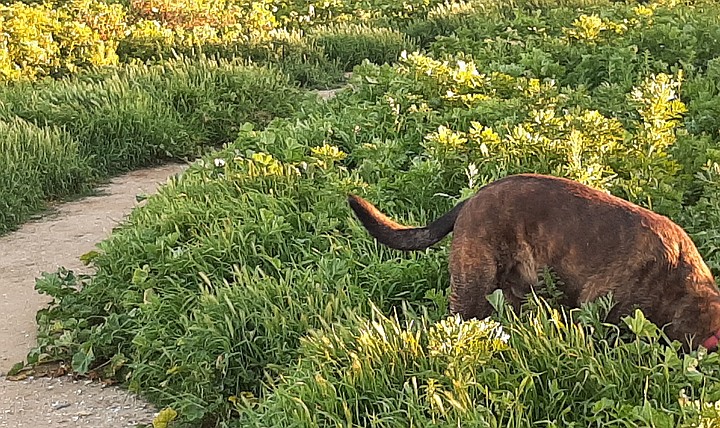 Facebook
Facebook
 X
X
 Instagram
Instagram
 TikTok
TikTok
 Youtube
Youtube

Fiesta Island’s fenced dog park reopened on Saturday after a four-day closure to mow weeds, including the dreaded foxtails and, unfortunately, the lovely yellow daisy shrubbed weeds. The mowing came after months of frustrating requests by Fiesta Island Dog Owners.
“I think they’re foolish to do it now,” FIDO president Carolyn Chase says. “We wanted it done weeks ago when the foxtails weren’t forming the seed pods and the daisies would still grow.”

According to Chase, FIDO was told that city parks has very limited resources and its mowing crews were busy taking care of ball fields and ‘parks’ jointly operated by the city and the San Diego Unified School District.
Parks spokesman Benny Cartwright confirms that the parks department has four tractors to tow mowing equipment and nine operators for the whole system, which comprises almost 1,300 acres citywide.
FIDO has applied for a city permit to bring in a contract mowing crew, Cartwright and Chase both confirmed. FIDO, an IRS registered nonprofit group, will have to raise an estimated $15,000 to mow the dog park and have the foxtails properly ground up – or removed, she said.
“You have to mow to match the rain cycles and catch them before they begin going to seed,” she said. “Otherwise, we end up with foxtails all over the ground where they’re just as dried up and invasive as they are if they dry naturally on the plant.”

Dr. Eric Olstad, who teaches veterinary medicine and practices at the University of California-Davis, said that prevention and management are “absolutely key” to keeping dogs from expensive and painful treatment for foxtail invasions.
“Foxtails go in one direction only by design,” Olstad says. “They burrow deeper and deeper.”
Olstad says he’s removed hundreds if not thousands of the nasty seedlings from dogs’ noses, eyes, ears, urethra and butts, and even chest cavities. And especially ears, noses and between the toes.
“You can tell if they’re in the eyes right away and if they got into the nose, the dog will be sneezing and pawing the face, and in the ears, they’ll paw and shake their heads like crazy. But the ones in their feet are more insidious — a lot of dogs will just continue to walk on them."
It can easily cost $1,000 to deal with foxtails and the aftermath of infections, he said.

Foxtail injuries are so common at veterinary hospitals that the staff has contests to see who removes the most – Olstad once removed 280 or so from a single dog. His wife is a veterinary pathologist, he said, and she has found them in the chest walls and hearts, and even the brain cavity of dead dogs.
Prevention and management includes going over the dog when you get home, hurrying to the vet at the first sign of invasion before the foxtail burrows, and regular checkups.
On Saturday, foxtail cuttings and plants were visible spread all over the areas that were mowed – and cheerfully waving in the wind on the plants on the slopes and next to the well-worn paths, where the mowers didn’t go.
“I try to keep Moose on the beach when there’s foxtails,” said Cal, who brought his mixed breed to the island from Pacific Beach. “And I spend an hour going over him for stickers when we get home. But we both love coming here so it’s a choice we make.”
FIDO is going forward with plans to use the city permit to mow earlier in foxtail season, Chase said, and will be trying to raise funds to pay for it.
“We can’t do it now until next March,” she said.


Fiesta Island’s fenced dog park reopened on Saturday after a four-day closure to mow weeds, including the dreaded foxtails and, unfortunately, the lovely yellow daisy shrubbed weeds. The mowing came after months of frustrating requests by Fiesta Island Dog Owners.
“I think they’re foolish to do it now,” FIDO president Carolyn Chase says. “We wanted it done weeks ago when the foxtails weren’t forming the seed pods and the daisies would still grow.”

According to Chase, FIDO was told that city parks has very limited resources and its mowing crews were busy taking care of ball fields and ‘parks’ jointly operated by the city and the San Diego Unified School District.
Parks spokesman Benny Cartwright confirms that the parks department has four tractors to tow mowing equipment and nine operators for the whole system, which comprises almost 1,300 acres citywide.
FIDO has applied for a city permit to bring in a contract mowing crew, Cartwright and Chase both confirmed. FIDO, an IRS registered nonprofit group, will have to raise an estimated $15,000 to mow the dog park and have the foxtails properly ground up – or removed, she said.
“You have to mow to match the rain cycles and catch them before they begin going to seed,” she said. “Otherwise, we end up with foxtails all over the ground where they’re just as dried up and invasive as they are if they dry naturally on the plant.”

Dr. Eric Olstad, who teaches veterinary medicine and practices at the University of California-Davis, said that prevention and management are “absolutely key” to keeping dogs from expensive and painful treatment for foxtail invasions.
“Foxtails go in one direction only by design,” Olstad says. “They burrow deeper and deeper.”
Olstad says he’s removed hundreds if not thousands of the nasty seedlings from dogs’ noses, eyes, ears, urethra and butts, and even chest cavities. And especially ears, noses and between the toes.
“You can tell if they’re in the eyes right away and if they got into the nose, the dog will be sneezing and pawing the face, and in the ears, they’ll paw and shake their heads like crazy. But the ones in their feet are more insidious — a lot of dogs will just continue to walk on them."
It can easily cost $1,000 to deal with foxtails and the aftermath of infections, he said.

Foxtail injuries are so common at veterinary hospitals that the staff has contests to see who removes the most – Olstad once removed 280 or so from a single dog. His wife is a veterinary pathologist, he said, and she has found them in the chest walls and hearts, and even the brain cavity of dead dogs.
Prevention and management includes going over the dog when you get home, hurrying to the vet at the first sign of invasion before the foxtail burrows, and regular checkups.
On Saturday, foxtail cuttings and plants were visible spread all over the areas that were mowed – and cheerfully waving in the wind on the plants on the slopes and next to the well-worn paths, where the mowers didn’t go.
“I try to keep Moose on the beach when there’s foxtails,” said Cal, who brought his mixed breed to the island from Pacific Beach. “And I spend an hour going over him for stickers when we get home. But we both love coming here so it’s a choice we make.”
FIDO is going forward with plans to use the city permit to mow earlier in foxtail season, Chase said, and will be trying to raise funds to pay for it.
“We can’t do it now until next March,” she said.
Comments